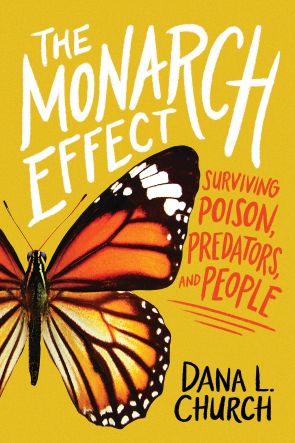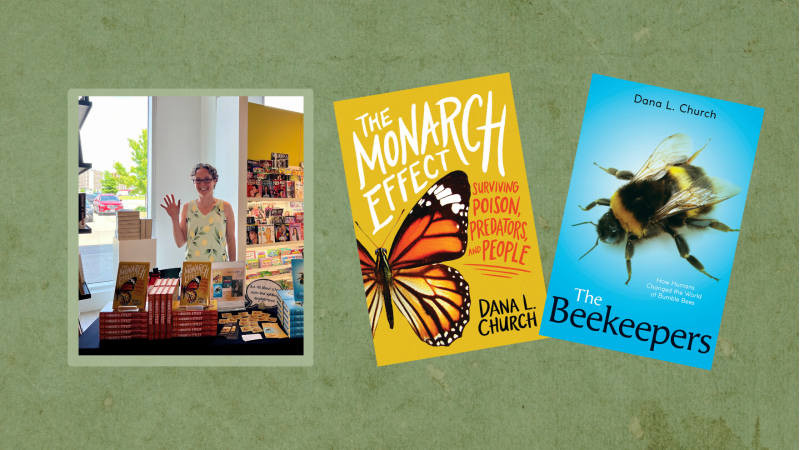This post was written by Brooks Jewell, Scholastic's Director of Internal Communications.

Barfing Bluejays, plants that ooze toxic latex, and winged creatures with sensory organs or “eyes” on their butts? It may sound like the beginning of another Scholastic Goosebumps tale, but it’s actually the very real, non-fiction account of our efforts to gain a better understanding of one of nature’s most stunning mysteries: the epic, 3,000-mile migration of monarch butterflies!

In celebration of National Insect Week (June 24 - 30), we spoke with Dana L. Church, author of the recently released The Monarch Effect and also The Beekeepers both published by Scholastic. Written for ages 8 to 12, Dana’s books look at how human intervention has impacted her subjects through fascinating stories of cognitive research, discovery, and scientific rivalry.
Like most kids, Dana grew up loving animals but admittedly – the cute furry ones. So, when she was tapped in graduate school for a research study on bumble bees – she panicked. “I was terrified of bees and insects, and I thought I’d be stung multiple times a day!”
Still, she decided to brave her fears and happily declares in her author bio that she was never stung once! Thus began a lifelong interest and love for insects that she hopes to pass on to the next generation.
“I want my readers to know that there is so much more to these little creatures than what we might see day to day and to spark in them a wonder and a curiosity to know more,” she explained. “There is still so much we don’t know, and maybe someone reading my books will be the one to solve these continuing mysteries.”
After the success of The Beekeepers, which was published in 2021, Dana’s agent suggested she write a book about butterflies, but it was such a broad topic, that she decided to narrow it down to monarchs (who do in fact have sensory organs at the ends of their abdomens – or butts).
“I wanted to find out what we know about these butterflies, and how they do what they do,” Dana said. “Their brains are so small, and yet they are able to migrate thousands of miles to a place they’ve never been before. While we have theories, we still aren’t sure how they manage it, and I hope that we can find out before it is too late!”
Dana’s book also describes the dramatic decline in the monarch population during the last decade, and while there are monarchs in other parts of the world, the North American variety is the only one known to migrate such unbelievable distances.
One thing Dana has to keep in mind when she’s writing is the young age of her audience. Not only in terms of scientific concepts -- such as the fact that milkweed secretes a toxic latex in hopes of sealing the mouths of caterpillars intent on eating them or that bumblebees can be trained to solve puzzles to gain a reward -- but also the sometimes darker sides of scientific research.
“There’s always competition,” Dana explained. “We tend to attribute a discovery to one person or a small group, but in reality many people from different areas may be working on the same questions.”
And in the case of monarchs – there is also suspected sexism, racism, and colonialism involved in the discovery of the insects’ overwintering grounds in Mexico. For instance, the sites were found by Catalina Trail and her husband Kenneth Brugger, who were working for Norah and Fred Urquhart (the scientists credited with the discovery). But when the story came out in National Geographic Catalina, a woman and Mexican, had almost no mention despite years of field work and research.
“And how do you discover something that Indigenous people have known about for years?” Dana asked. “It’s a very colonial mindset.”
At first, Dana was unsure if she should cover those aspects of the research in her book but decided it would be doing her young readers a disservice to leave it out. She also thought that children might appreciate knowing that adults are not always perfect either. She said Jody Corbett, Scholastic’s Senior Editor, Trade, was a great resource.
 “Jody was so amazingly helpful. She really guided me and helped me understand how best to talk about these topics with kids,” Dana said.
“Jody was so amazingly helpful. She really guided me and helped me understand how best to talk about these topics with kids,” Dana said.One consideration when describing complex topics, Dana explained, is simplicity. “I have an academic background, but I hated writing academic papers. I always appreciated plain language, which is why I think so many kids and even adults, can enjoy the books. I guess ultimately, I wrote books that I would have wanted to read as a kid.”
As a scientist, clearly rooted in conservation, Dana’s books emphasize the need to study animals and insects in order to save them.
“The more research we do, the more we are discovering that animals are capable of very complex behaviors and emotions. They are sentient beings with brains, a consciousness, and the capability to learn. Now that we know so much more about the monarchs and what’s contributing to their decline, as well as the catastrophic impact of pesticides on bees, we can begin to repair some of the damage that we’ve done.”
The books also touch on the need to work with Indigenous populations who have always had a much more symbiotic relationship with the natural world. Combining western research with Indigenous knowledge – something known as Two-Eyed Seeing, can benefit all of us.
At the end of The Monarch Effect, Dana offers a number of terrific ways her readers can not only monitor and track these amazing creatures – but how to help save them – and many are good for bees too.
One of the most important is to plant milkweed native to your area in your yard or community garden. Not only do monarch caterpillars love to eat them, the flowers provide nectar for many butterflies, bees, and other pollinators.
She also encourages everyone to check out organizations like Monarch Watch and Bumble Bee Watch to learn more and help track sightings. Getting community help and support through citizen scientists, has contributed to an outpouring of support for these vulnerable species. “So, there is hope,” Dana said. “That we are seeing a global wave of change in how we coexist with these remarkable and beautiful creatures.”



